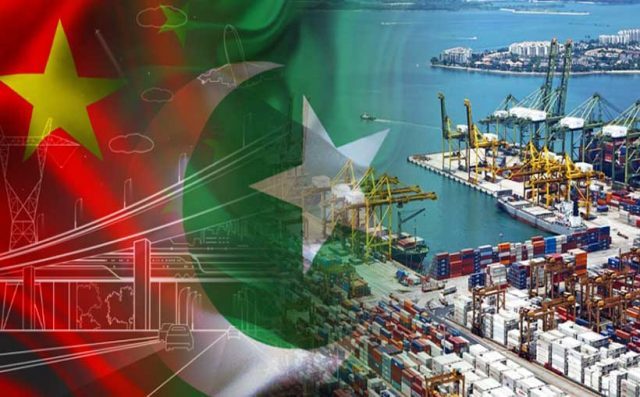Waqas Shabbir |
The China Pakistan Economic Corridor (CPEC) is hailed as the best opportunity to have knocked at Pakistan’s door, after a long stalemate in Pakistan’s economy. Though in the early years of General Musharaf’s era, on the back of financial aid and grants, the economy did progress well, but lack of structural reforms lead to continuity in dismissal affairs with no concrete steps to avert the crises prone economy. The habitual movement in cycles remained a norm for an economy which suffered from trade and fiscal deficits, energy shortages, and relied on foreign institutions to bail out the country when needed.
Read more: CPEC in the eyes of an economic guru
At a time, when Pakistan’s economy found itself unwanted and the war on terror and its repercussions ran havoc in the country and major law and order situation put the economy on the brink. It discouraged the foreign investors investors from investing in Pakistan, and at the time, when none of the leading economies and superpowers were interested to invest in Pakistan, China came along with its dream project to reinvent and redesign its historic silk road to continue its ascendancy as the best economy in the world overpowering the US in the process.
Political parties may take credit for CPEC. But, in fact, it is Chinese necessity turned into a blessing in disguise for Pakistan.
Critics may attack CPEC and confer accusations on Pakistan for selling the interests of Pakistan. Some analysts lament confusion over the allocation of expected dividends of the project. Transparency of the project remained controversial, but there is no denying that CPEC was the only alternative which Pakistan had at its disposal to squeeze out of the economic quagmire.
Read more: There ain’t no such thing as a free lunch: “CPEC is…
Where CPEC improved the structure of Pakistan’s road, railway, and transformed the ports, and boosted energy sector which added 10,000-12,000 megawatt electricity into the system, it also created problems, which are expected to evaporate in few years, if policy makers make right policies.
Pakistan faced an uphill task in China-Pakistan Free Trade Agreement (CPFTA). Analysts and business community have shown concerns over FTA with China. Due to unfair terms agreed in Phase-I-which largely benefited Chinese businesses at the expense of local manufacturers who faced huge losses due to demand for products being imported from China.
In addition, machinery imported under the CPEC has been a major blow to the trade balance. Economists brushed off the fears due to the import of capital goods which has now started to decline.
Pakistan will face a daunting task to pay off the existing external loans.
Under phase-II, China has thus far not accepted Pakistan demands to relax tariffs, on already negotiated items in Phase-I. It is believed that next round of talks will be held with the new government after 2018 general elections.
Currently, a major chunk of Pakistan’s $32 billion trade deficit is due to the bilateral trade deficit with China. Under FTA China’s exports jumped from $3.5 billion to over $16 billion, making it the biggest trading partner of Pakistan.
It is certainly not in Pakistan’s interest to continue under existing duties/tariffs which not only benefits China through trade but, loans generated from China to bridge the fiscal and trade deficit only facilitates China on Pakistan’s expense.
Read more: What are the reasons behind growing trend of anti-CPEC coverage in…
Where CPEC brought prosperity, it has brought challenges to devise effective internal policies, otherwise, it can create even a greater burden, amid ballooning external debt.
Under CPEC, in Pakistan’s labor-intensive economy, unless China does not install industries which benefits the local unskilled labor and local manufacturers, Pakistan will face a daunting task to pay off the existing external loans.
The Chinese industries in special economic zones can hire unskilled and skilled workers from Pakistan and spillover effects of Chinese industries may benefit Pakistani counterparts. But, this has its own limits, it cannot hire all unemployed and new entrants in the job market. Pakistan will have to create its own avenues for this.
Read more: CPEC: Pakistan’s quest for energy security
Pakistan mainly rely on loans from China, and other institutional lenders, to bridge the gap between balance of payments and current account deficit and fiscal deficit, but unless it doesn’t improve its exports and does not utilize the borrowed money on asset building, it will continue its dependence on external elements to assist the economy.
With the passage of time, Pakistan will have to improve its competitiveness, formulate effective export and industrial policy which may discourage debt accumulation.
Pakistan will have to shift its focus to pre-emptive measures to boost its exports, improve the tax base, certain austerity measures at the provincial and federal level, less reliance on remittances, and administrative measures to support fiscal consolidation can help bridge the twin deficit.
Read more: Pakistan withdraws from Chinese dam building deal. What does this mean…
Political stability is crucial to lure investors. Unless Pakistan doesn’t bring its own house in order, dividend attached to CPEC cannot be realized.
Waqas Shabbir is a Derby Business School graduate in Finance, currently working as a freelance writer. The views expressed are those of the author and do not necessarily reflect GVS editorial policy.














